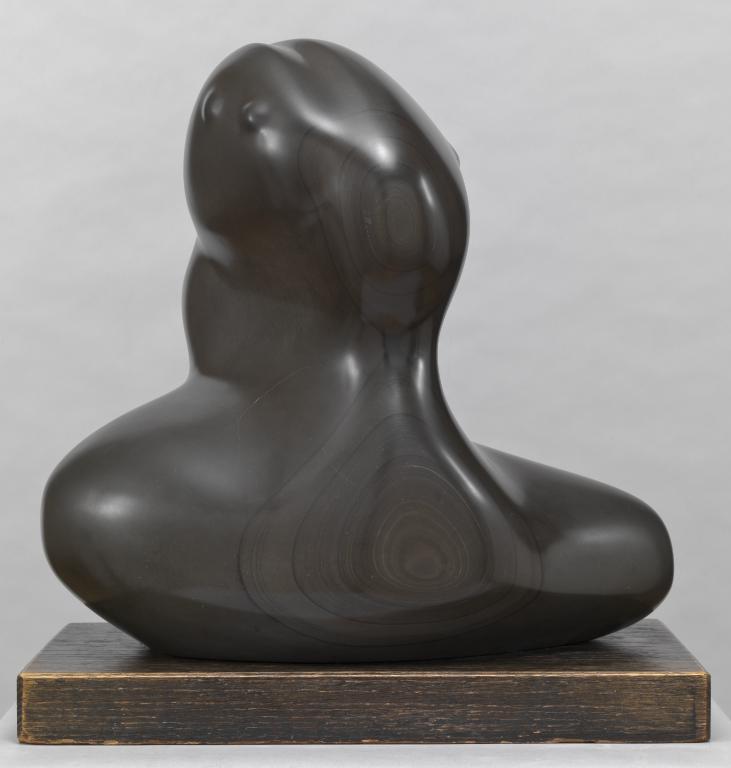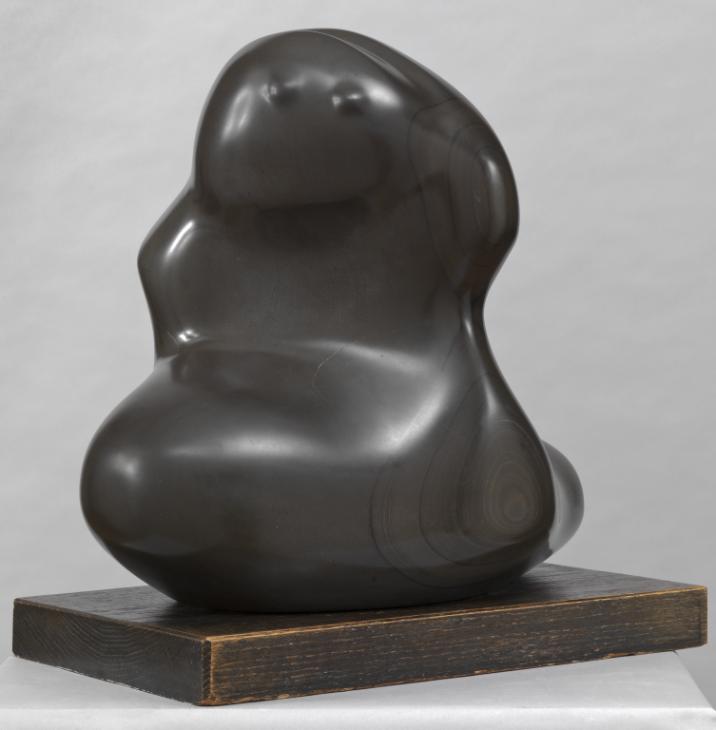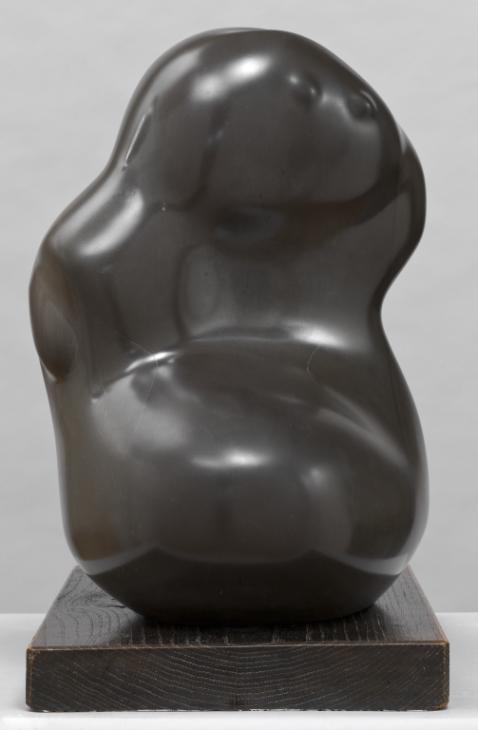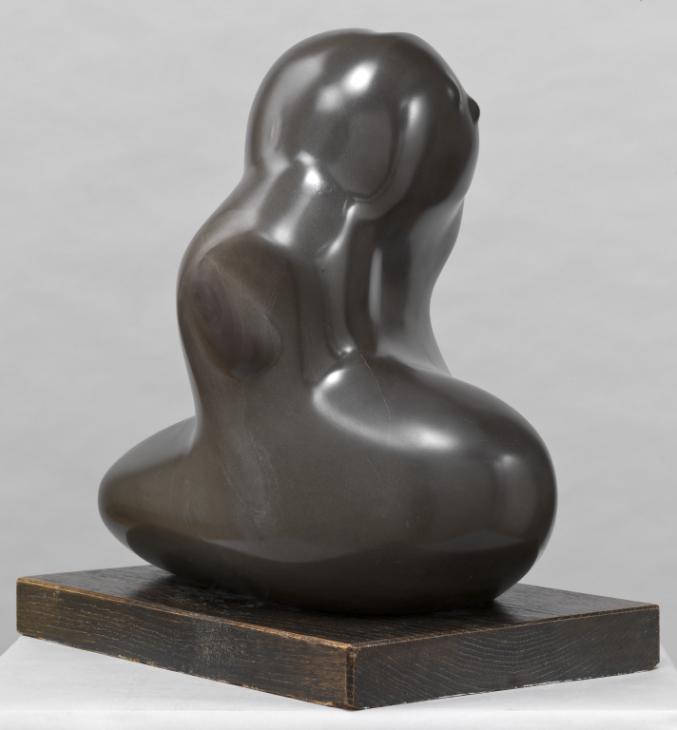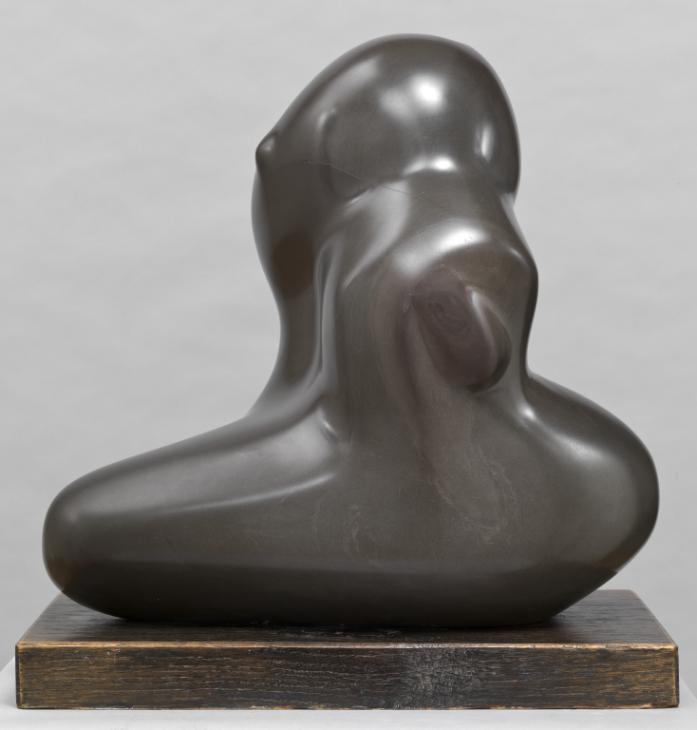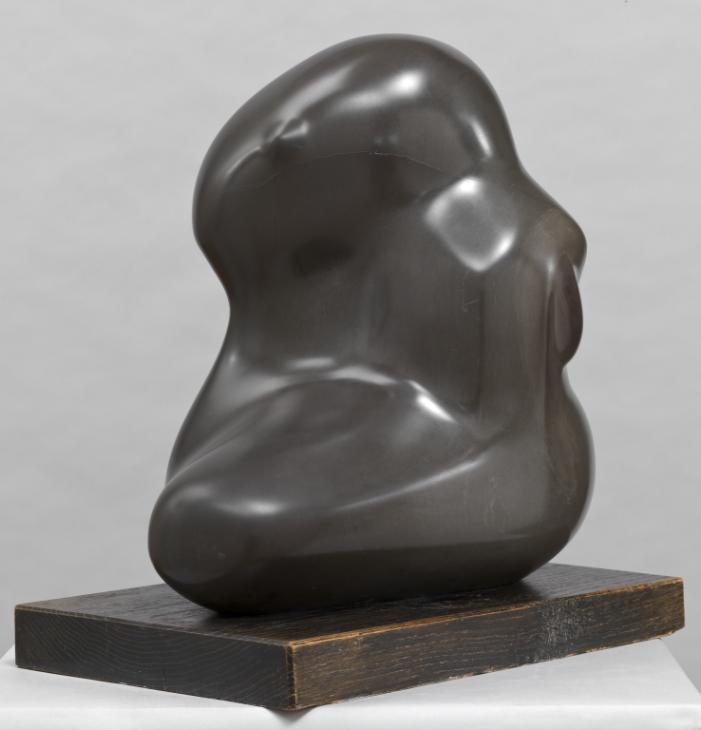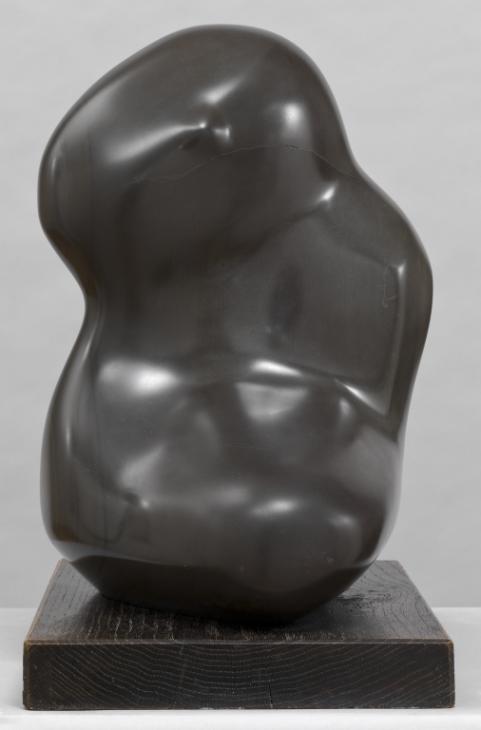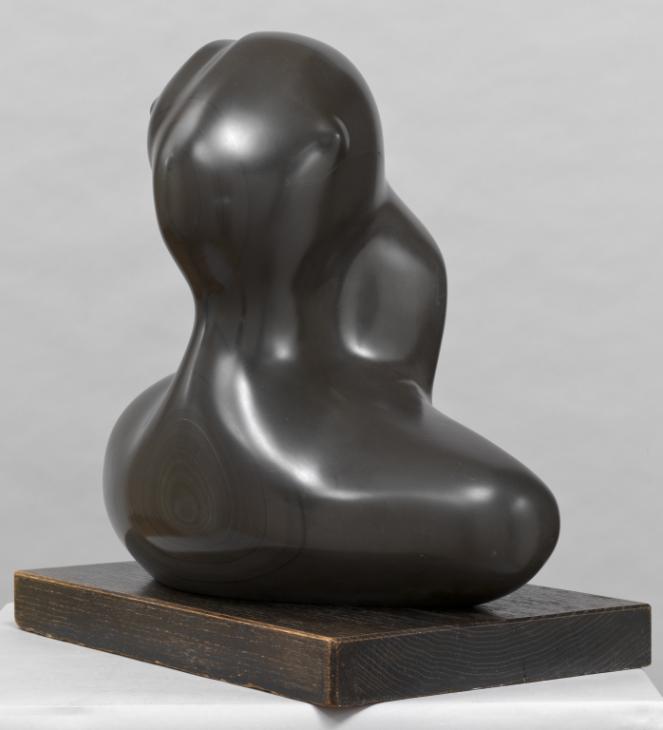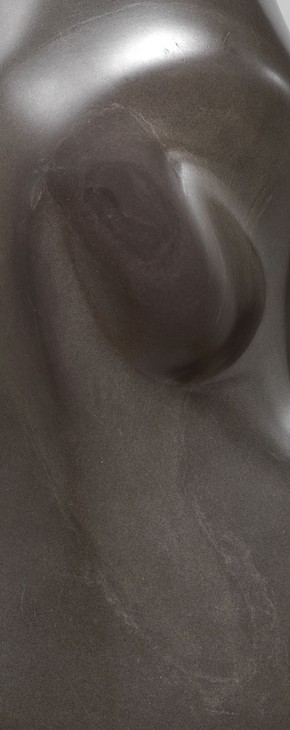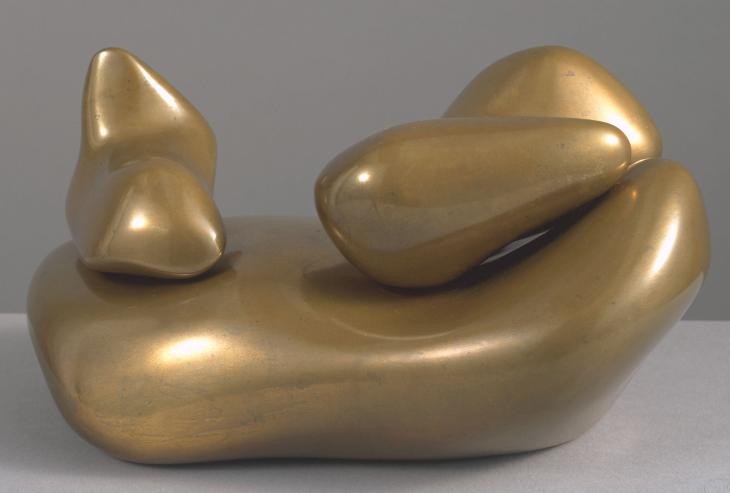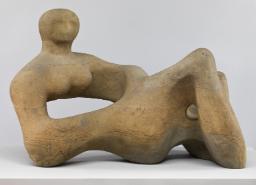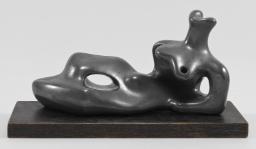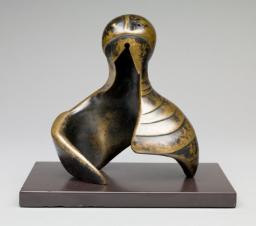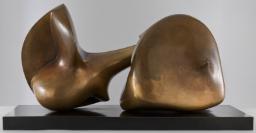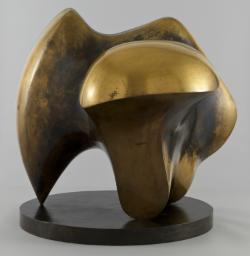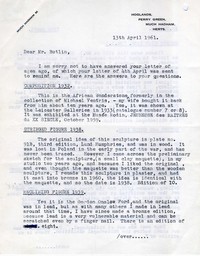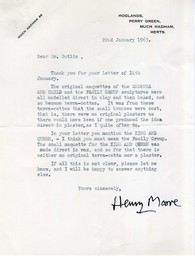Henry Moore OM, CH Composition 1932
Image 1 of 8
-
 Henry Moore OM, CH, Composition 1932© The Henry Moore Foundation. All Rights Reserved© The Henry Moore Foundation. All Rights Reserved
Henry Moore OM, CH, Composition 1932© The Henry Moore Foundation. All Rights Reserved© The Henry Moore Foundation. All Rights Reserved -
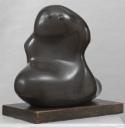 Henry Moore OM, CH, Composition 1932© The Henry Moore Foundation. All Rights Reserved© The Henry Moore Foundation. All Rights Reserved
Henry Moore OM, CH, Composition 1932© The Henry Moore Foundation. All Rights Reserved© The Henry Moore Foundation. All Rights Reserved -
 Henry Moore OM, CH, Composition 1932© The Henry Moore Foundation. All Rights Reserved© The Henry Moore Foundation. All Rights Reserved
Henry Moore OM, CH, Composition 1932© The Henry Moore Foundation. All Rights Reserved© The Henry Moore Foundation. All Rights Reserved -
 Henry Moore OM, CH, Composition 1932© The Henry Moore Foundation. All Rights Reserved© The Henry Moore Foundation. All Rights Reserved
Henry Moore OM, CH, Composition 1932© The Henry Moore Foundation. All Rights Reserved© The Henry Moore Foundation. All Rights Reserved -
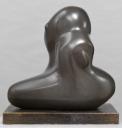 Henry Moore OM, CH, Composition 1932© The Henry Moore Foundation. All Rights Reserved© The Henry Moore Foundation. All Rights Reserved
Henry Moore OM, CH, Composition 1932© The Henry Moore Foundation. All Rights Reserved© The Henry Moore Foundation. All Rights Reserved -
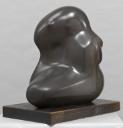 Henry Moore OM, CH, Composition 1932© The Henry Moore Foundation. All Rights Reserved© The Henry Moore Foundation. All Rights Reserved
Henry Moore OM, CH, Composition 1932© The Henry Moore Foundation. All Rights Reserved© The Henry Moore Foundation. All Rights Reserved -
 Henry Moore OM, CH, Composition 1932© The Henry Moore Foundation. All Rights Reserved© The Henry Moore Foundation. All Rights Reserved
Henry Moore OM, CH, Composition 1932© The Henry Moore Foundation. All Rights Reserved© The Henry Moore Foundation. All Rights Reserved -
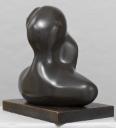 Henry Moore OM, CH, Composition 1932© The Henry Moore Foundation. All Rights Reserved© The Henry Moore Foundation. All Rights Reserved
Henry Moore OM, CH, Composition 1932© The Henry Moore Foundation. All Rights Reserved© The Henry Moore Foundation. All Rights Reserved
© The Henry Moore Foundation. All Rights Reserved
Henry Moore OM, CH,
Composition
1932
© The Henry Moore Foundation. All Rights Reserved
Composition 1932 recalls the form of a portrait bust but its globular appearance reflects Moore’s interest in natural forms such as pebbles, and testifies to the influence of Pablo Picasso and Jean Arp on Moore’s experiments with abstraction in the early 1930s.
Henry Moore OM, CH 1898–1986
Composition
1932
African wonderstone on a stained oak base
445 x 457 x 298 mm
Presented by the Friends of the Tate Gallery 1960
T00385
Composition
1932
African wonderstone on a stained oak base
445 x 457 x 298 mm
Presented by the Friends of the Tate Gallery 1960
T00385
Ownership history
Acquired by Michael Ventris prior to 1944, from whom purchased by Mrs Irina Moore (Henry Moore’s wife) in November 1955, from whom purchased by the Friends of the Tate Gallery in 1960.
Exhibition history
1933
Sculpture and Drawings by Henry Moore, Leicester Galleries, London, November 1933, no.7 or 8.
1946–7
Henry Moore, Museum of Modern Art, New York, December 1946–March 1947; Art Institute of Chicago, Chicago, April–May 1947; San Francisco Museum of Art, San Francisco, July–August 1947, no.19.
1947–8
Exhibition of Sculpture and Drawings by Henry Moore, British Council touring exhibition: Art Gallery of New South Wales, Sydney; Tasmanian Museum and Art Gallery, Hobart; National Gallery of Victoria, Melbourne; Art Gallery of South Australia, Adelaide; Art Gallery of Western Australia, Perth, 1947–8, no.2.
1949
Henry Moore: Sculpture and Drawings 1923–1948, Wakefield City Art Gallery, Wakefield, April–May 1949; Manchester City Art Gallery, Manchester, June–July 1949, no.27.
1949–50
Henry Moore, British Council touring exhibition: Palais des Beaux-Arts, Brussels, October 1949; Musée d’art moderne, Paris, December 1949; Stedelijk Museum, Amsterdam, January 1950; Hamburger Kunsthalle, Hamburg, March 1950; Städtische Kunstsammlungen, Düsseldorf, May 1950; Kunsthalle Berne, Berne, June–July 1950, no.19.
1951
An Exhibition of Sculpture and Drawings organised by the British Council, Zappeion Gallery, Athens, March 1951, no.6.
1951
Sculpture and Drawings by Henry Moore, Tate Gallery, London, May–July 1951, no.87.
1952
Henry Moore: skulpturer och teckningar, Riksförbundet för bildande konst, Stockholm, 1952, no.6.
1952
The Meaning of Sculpture: Built Round Sculptures and Drawings by Henry Moore, Van Riebeeck Tercentenary Festival, South African National Gallery, Cape Town, 1952, no.6.
1953
Henry Moore, Museum Boymans van Beuningen, Rotterdam, May–July 1953, no.7.
1959
Jeunesse des Maitres du XX siècle, Musée Rodin, Paris, October 1959.
1968
Henry Moore, Tate Gallery, London, July–September 1968, no.27.
1973
Henry Moore to Gilbert & George: Modern British Art from the Tate Gallery, Palais des Beaux-Arts, Brussels, September–November 1973, no.27.
1976
Sculpture for the Blind, Tate Gallery, London, November 1976.
1977
Henry Moore: Sculptures et dessins, Musée de l’Orangerie des Tuileries, Paris, May–August 1977, no.1212.
1978
The Henry Moore Gift, Tate Gallery, London, June–August 1978, no number.
1981
Henry Moore: Sculptures, Drawings, Graphics 1921–1981, Palacio de Velázquez, Palacio de Cristal, Parque de El Retiro, Madrid, May–August 1981, no.69.
1984–5
Henry Moore: Sculpture in the Making, Leeds City Art Gallery, Leeds, November 1984–January 1985, no.7.
1998
Henry Moore 1898–1986: ein Retrospektive zum 100 Geburtstag, Palais Harrach Kunsthistorisches Museum, Vienna, March–August 1998, no.56.
2001–2
Henry Moore: Sculpting the 20th Century, Dallas Museum of Art, Dallas, February–May 2001; Legion of Honor, San Francisco, June–September 2001; National Gallery of Art, Washington D.C., October 2001–January 2002, no.21.
2002
Henry Moore: Rétrospective, Fondation Maeght, Saint-Paul, July–November 2002, no.33.
2010–11
Henry Moore, Tate Britain, London, February–August 2010; Art Gallery of Ontario, Toronto, October 2010–February 2011; Leeds Art Gallery, Leeds, March–June 2011, no.45.
2012
Picasso and Modern British Art, Tate Britain, London, February–July 2012; Scottish National Gallery of Modern Art, Edinburgh, August–November 2012, no number.
2013
Ice Age Art, British Museum, London, February–June 2013.
References
1934
Herbert Read, Henry Moore: Sculptor, London 1934, reproduced pl.31.
1933
Geoffrey Grigson, ‘Henry Moore and Ben Nicholson’, Bookman, vol.85, no.506, November 1933, p.106, reproduced.
1944
Herbert Read (ed.), Henry Moore: Sculpture and Drawings, London 1944, reproduced pls.33a–33b.
1948
A.D.B. Sylvester, ‘The Evolution of Henry Moore’s Sculpture: I’, Burlington Magazine, vol.90, no.543, June 1948, pp.158–65, reproduced p.159.
1951
David Sylvester (ed.), Sculpture and Drawings by Henry Moore, exhibition catalogue, Tate Gallery, London 1951, p.12.
1955
George Wingfield Digby, Meaning and Symbol in Three Modern Artists: Edvard Munch, Henry Moore, and Paul Nash, London 1955, p.72, reproduced pl.29.
1957
David Sylvester (ed.), Henry Moore. Volume 1: Complete Sculpture 1921–48, London 1957, p.8, no.119, reproduced p.79.
1968
John Russell, Henry Moore, London 1968, reproduced p.45.
1970
Robert Melville, Henry Moore: Sculpture and Drawings 1921–69, London 1970, reproduced fig.69.
1973
John Russell, Henry Moore, 1968, 2nd edn., London 1973, reproduced p.73.
1981
Henry Moore, exhibition catalogue, Foundation Maeght, Paris 2002, reproduced p.69.
1984
Henry Moore: Sculpture in the Making, exhibition catalogue, Leeds City Art Gallery, Leeds 1984.
1998
Henry Moore 1898–1986: ein Retrospektive zum 100 Geburtstag, exhibition catalogue, Palais Harrach Kunsthistorisches Museum, Vienna 1998, reproduced p.204.
2001
Henry Moore: Sculpting the 20th Century, exhibition catalogue, Dallas Museum of Art, Dallas 2001, pp.43–51, reproduced p.100.
2005
Anne Wagner, Mother Stone: The Vitality of Modern British Sculpture, New Haven and London 2005, reproduced p.247.
2007
Jeremy Lewison, Henry Moore 1898–1986, Cologne 2007, reproduced p.31.
2010
Chris Stephens (ed.), Henry Moore, exhibition catalogue, Tate Britain, London 2010, reproduced p.130.
2012
Christopher Green, ‘Henry Moore and Picasso’, in James Beechy and Chris Stephens (eds.), Picasso and Modern British Art, exhibition catalogue, Tate Britain, London 2012, pp.130–49, reproduced p.140.
Technique and condition
Composition is a biomorphic sculpture carved from a single piece of African wonderstone, a fine-grained sedimentary rock that can take a high polish. The sculpture is attached to a black-stained rectangular oak base with a single central bolt.
To make this sculpture Moore would have first roughed out the shape of its form using a hammer and chisels. The shape would then have been further refined using different sizes of file before being sanded and polished with progressively finer abrasives. The high polish has been achieved over the entire surface, so that no tool marks can be seen. The sedimentary layers of the rock are fully visible and Moore seems to have taken advantage of these by orientating the stone so that they are in the vertical plane thereby ensuring that the contours of the form are highlighted (fig.1).
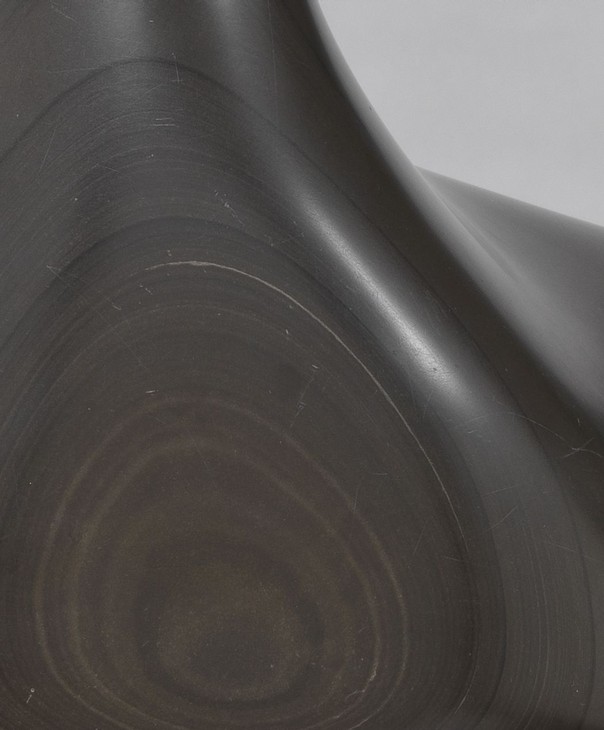
Henry Moore
Detail of sedimentary layers in Composition 1932
Tate T00385
© The Henry Moore Foundation. All Rights Reserved
Fig.1
Henry Moore
Detail of sedimentary layers in Composition 1932
Tate T00385
© The Henry Moore Foundation. All Rights Reserved

Henry Moore
Detail of repair on Composition 1932
Tate T00385
© The Henry Moore Foundation. All Rights Reserved
Fig.2
Henry Moore
Detail of repair on Composition 1932
Tate T00385
© The Henry Moore Foundation. All Rights Reserved
Two small holes in the top surface of the sculpture have been restored at Tate by filling them and in-painting so that they are no longer visually distracting (fig.2). There is no inscription visible.
Lyndsey Morgan
October 2011
How to cite
Lyndsey Morgan, 'Technique and Condition', October 2011, in Alice Correia, ‘Composition 1932 by Henry Moore OM, CH’, catalogue entry, January 2013, in Henry Moore: Sculptural Process and Public Identity, Tate Research Publication, 2015, https://wwwEntry
Composition 1932 is a sculpture in dark brown African wonderstone. In that it comprises a vertical form that swells upwards from the centre of a broader base, the sculpture is loosely reminiscent of a portrait bust – a head and neck rising from shoulders – although these human characteristics are not represented with any anatomical accuracy. Instead the sculpture is made up of rounded globular forms that seem to melt into each other, an effect achieved by the highly-polished finish. This in turn makes the sculpture appear as though it might be soft to touch. The forms curve upwards and outwards so that the widest part of the sculpture overhangs its own bottom edge, which sits on a cuboid base of stained oak.
When seen from the front, the central swelling – which could be deemed to be a human head – appears to be looking over the left shoulder. Two evenly-spaced convex bumps are suggestive of eyes, but there are no other protrusions, indentations or incisions that could be understood as facial features. Viewed from this angle the neck does not appear to be cylindrical as might be expected, but takes the shape of a rounded cuboid. At the front the neck curves inwards and narrows before sloping downwards and outwards to create a convex breastbone or chest. The curve of the chest is emphasised by the concentric rings of the sedimentary rock layers, which ripple outwards from the apex of the curve, towards two unevenly sized and shaped shoulders. The left shoulder is taller but narrower than the right, which appears to project backwards as though the sculpture has not been squared with the front but is instead presented on a diagonal.
Viewed from the side, the neck is seen to be wider than the head section, exacerbated by the presence of a rounded protrusion at the rear; this convex element at the nape of the neck replicates the concave curve of the neck and throat. However, its presence unbalances the head, which seems to be pulled backwards and down. From the rear the bulbous protrusion may be understood as a bun of hair or a ponytail, on which is a smaller, second bulge. The hair melts or fuses into the shoulder blades at the back of the sculpture. From this position, the horizontal section of the sculpture which forms the two shoulders appears to exist on a continuous diagonal from the lower left shoulder to the upper right, and when considered a single element resembles a rounded conical shape.
Viewed from the side, the neck is seen to be wider than the head section, exacerbated by the presence of a rounded protrusion at the rear; this convex element at the nape of the neck replicates the concave curve of the neck and throat. However, its presence unbalances the head, which seems to be pulled backwards and down. From the rear the bulbous protrusion may be understood as a bun of hair or a ponytail, on which is a smaller, second bulge. The hair melts or fuses into the shoulder blades at the back of the sculpture. From this position, the horizontal section of the sculpture which forms the two shoulders appears to exist on a continuous diagonal from the lower left shoulder to the upper right, and when considered a single element resembles a rounded conical shape.
From the right side, the head has another conical bump which is suggestive of an eye. However, because there is only one it is possible that when seen from this particular position, the sculpture may be understood as presenting a profile view, with the convex curve that joins the head and neck seemingly outlining a chin.
Although some cracks in the stone are visible, the sculpture has a generally consistent, smooth, polished surface. African wonderstone is a fine-grained sedimentary rock, which, as Composition demonstrates, can be smoothed and polished to a high finish. African wonderstone is quarried in South Africa and is a type of pyrophillite stone, comprising silica and alumina. The hardness of the stone lies between that of alabaster and marble and usually comes in dark grey and black colours, although a burgundy plume can sometimes be found running through the stone, as can be seen in the veining at the rear of Composition (fig.1). Moore’s use of African wonderstone for this sculpture is unusual; most of his carvings from the late 1920s and early 1930s were created in English stones. Early in his career Moore had made a point of using native materials, which were not only cheaper than foreign stones but rarely used for free-standing sculpture. In this way Moore challenged the conventions of sculpture, which had traditionally been carved in marble or cast in bronze. By experimenting with African wonderstone Moore again chose to break from convention.
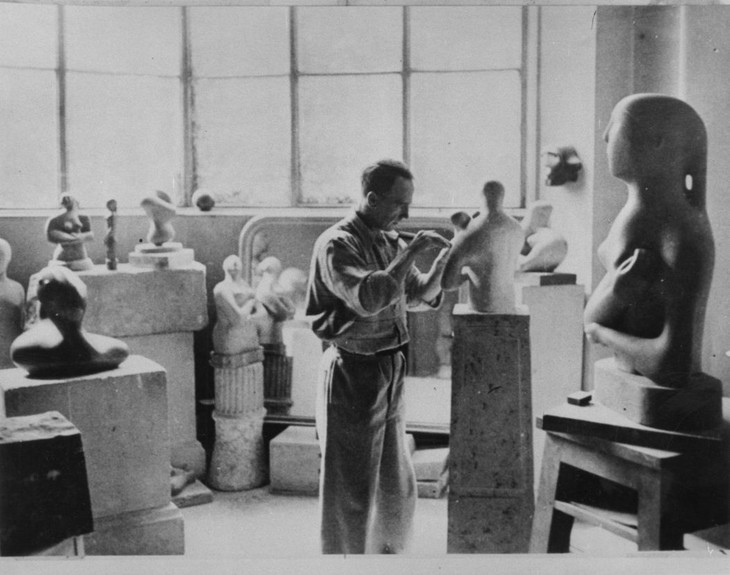
Henry Moore in his studio at 11a Parkhill Road, London in 1932
The Henry Moore Foundation
© The Henry Moore Foundation. All Rights Reserved
Fig.2
Henry Moore in his studio at 11a Parkhill Road, London in 1932
The Henry Moore Foundation
© The Henry Moore Foundation. All Rights Reserved
Composition, like Hepworth’s Seated Figure, can be described as an abstract sculpture. At the time Moore was working, the word ‘abstract’ was applied to a wide range of different styles and artistic tendencies. For example, the influential art critics Herbert Read and R.H. Wilenski, both of whom had championed Moore’s work in their writings, had been using the word to describe artworks that evoked figures and objects that existed in the real world but which had been manipulated or transformed by the artist so as to arrive at a more or less simplified or schematised arrangement of forms. Thus in the early 1930s the term ‘abstract’ did not simply mean ‘non-representational’.2 Indeed Moore also understood that abstraction could denote taking ‘steps away from realistic representation’.3 He believed that ‘all art is abstraction to some degree’, going on to note that ‘in sculpture material alone forces one away from pure representation and towards abstraction’.4 As an anatomical abstraction Composition is demonstrative of how Moore chose to stretch the boundaries of his sculptural vocabulary while simultaneously maintaining a commitment to the figurative form.
Moore created Composition using the method of direct carving. This meant that he worked directly on the stone, using a range of chisels, rifflers and hammers without the aid of preparatory sketches or maquettes (scale models made in clay or plaster). Moore and his contemporaries, including Hepworth, believed that when carving directly into stone or wood to create a unique artwork, the form or shape of the final sculpture should evolve through the processes of its making, as the artist responded to the texture, graining and colour of the material under hand. In 1934 Moore articulated the approach he had been taking in the early 1930s in his statement for the publication Unit One:
Every material has its own individual qualities. It is only when the sculptor works direct, when there is an active relationship with his material, that the material can take its part in the shaping of an idea. Stone, for example, is hard and concentrated and should not be falsified to look like soft flesh – it should not be forced beyond its constructive build to a point of weakness. It should keep its hard tense stoniness.5
Believing that to depict a human figure in stone was already an act of abstraction, Moore sought to harness the inherent characteristics of the African wonderstone rather than make it look like flesh. Sculpted decoration or adornments were thus rejected in favour of uncluttered surfaces that emphasised its inky blackness and veining. In Composition Moore seems to have harnessed the stratification of the stone to create concentric rings on the frontal area that emphasise the curved nature on the breastbone and head. For a carving of this kind Moore believed that prioritising the inherent characteristics of the raw material would provide the sculpture with what he described as its own ‘vitality ... an intense life of its own, independent of the object it may represent’.6
Direct carving and the doctrine of ‘truth to materials’ led Moore and his contemporaries to think about the inherent qualities of their materials, and how those materials are shaped and manipulated in the natural environment. As well as meeting regularly with his Hampstead neighbours to discuss artistic ideas, Moore and his friends took summer holidays together on the coast of Norfolk, notably at Happisburgh in 1930 and 1931. Hepworth and Skeaping had accompanied Moore on the 1930 trip where they all became interested in the shapes of the weathered ironstone and flint pebbles found on the beach. Bearing in mind the date Composition was carved, it is easy to interpret the sculpture in relation to Moore’s appreciation of the naturally smoothed forms of pebbles and stones. In 1932 Moore explained:
During visits to the Norfolk coast I began collecting flint pebbles. These showed Nature’s treatment of stone and the principle of the opposition of bumps and hollows. Then I realised that a work loses in interest through having its component forms too similar in size, and began putting small forms against large forms, enlarging some and reducing others.7
This realisation may account for the arrangement of forms of different sizes in Composition. The sculpture includes a number of bumps, undulations and hollows, while the varying size and shape of the two shoulders creates a point of interest or contrast in the sculpture. These contrasting elements contributed to what Moore called ‘full three-dimensional realisation’, by which he meant that the sculpture existed, and demanded to be viewed in the round.8 Composition looks significantly different according to the angle or position from which it is viewed, and it may be understood as an example of Moore’s belief that ‘sculpture fully in the round has no two points of view alike’.9
Composition was exhibited in Moore’s solo exhibition at the Leicester Galleries in London in November 1933. This was his second one-person show at the gallery and he went on to exhibit there regularly throughout the decade. Reviews of Moore’s exhibition in the printed press were mixed. Although most reviewers acknowledged Moore as one of the country’s leading modern artists, there was disagreement as to whether his work was ‘most unpleasing’,10 and ‘a serious misuse of material’,11 or, as the critic and Moore’s neighbour on Parkhill Road Adrian Stokes concluded in the Spectator, ‘novel and lovely’.12 An unnamed critic for the Times noted that Moore’s sculpture fell into two opposing categories – the figurative and the abstract – and suggested that Composition ‘seems to have grown out of the promptings of the material – as a man might work and polish a pebble which happened vaguely to suggest a human or animal figure’.13 Although the critic did not explicitly reference direct carving or the doctrine of truth to materials it seems that Moore’s sculptures were nonetheless understood in these terms and the assessment of Moore’s work as prompting recollections of natural, organic and human forms dominated published criticism throughout the early 1930s. For example, in his essay for the 1934 publication Henry Moore: Sculptor, Herbert Read stated that Moore was ‘so familiar with the ways of nature – particularly the ways of growth – that he can out of the depth and sureness of that knowledge create ideal forms which have all the vital rhythm and structure of natural forms’.14 This analysis was reinforced by Moore’s own essay for Unit One, edited by Read and published the same year, in which he stated that, ‘I have found principles of form and rhythm from the study of natural objects such as pebbles, rocks, bones, trees, plants, etc’.15
As an anatomical abstraction, Composition demonstrates how far Moore was prepared to move away from the naturalistic depiction of the human body while maintaining a commitment to it. In 1932, the year Composition was made, Moore identified the human forms as the fulcrum of his work:
As with the flints I have studied the principles of organic growth in the bones and shells at the Natural History Museum and have found new form and rhythm to apply to sculpture. Of course one does not just copy the form of a bone, say, into stone, but applies the principles of construction, variety, transition of one form into another, to some other subject – with me nearly always the human forms, for that is what interests me – so giving, as the image and metaphor do in poetry, a new significance to each.16
That the sculpture can be understood simultaneously as a figurative form and undefined organic matter is testament to Moore’s belief that ‘All the best sculpture I know is both abstract and representational at the same time’.17

Henry Moore
Seven Ideas for Sculpture 1931
Pen and ink, wash, watercolour on paper
372 x 273 mm
Private collection
© The Henry Moore Foundation. All Rights Reserved
Photo: Henry Moore Foundation Archive
Fig.3
Henry Moore
Seven Ideas for Sculpture 1931
Private collection
© The Henry Moore Foundation. All Rights Reserved
Photo: Henry Moore Foundation Archive
While the mainstream journalists remained largely divided over the aesthetic qualities of Moore’s work, the artist found support in the writings of the literary critic Geoffrey Grigson. In November 1933 Grigson, who earlier that year had launched New Verse, a periodical that was to become the most influential poetry magazine of the decade, wrote an article for his regular art column in the Bookman, a monthly arts and literature magazine, in which he encouraged readers to visit Moore’s exhibition at the Leicester Galleries.20 Following a discussion of Herbert Read’s book Art Now, in which Read accounted for the emergence of a type of non-representational art comprising arrangements of geometric shapes characterised by Ben Nicholson’s Milk and Plain Chocolate 1933 (private collection), Grigson noted that Moore’s work was also ‘going further and further from [the] representation of nature in naturalistic terms’.21 In what was essentially a promotional preview of Moore’s exhibition, Grigson noted that ‘Moore’s works in wood and stone are works in the nature of their material, and yet [are] organisms which have grown outwards from their centre, inevitably’.22 Accompanied by a reproduction of Composition, Grigson’s text championed Moore’s abstracted forms as the products of a ‘passionate and undivided imagination’, and concluded that ‘looking at a good piece by Mr Moore, one is made at once happy. One is elevated by its unity and ease. It is complete and solid. It is harmonious, surprising and exhilarating’.23
Two years later Grigson discussed Moore’s organic sculptures, such as Composition, in his essay ‘A Comment on England’, published in the first edition of the magazine Axis. In his essay, Grigson characterised Moore as follows:
MOORE: Product of the multiform inventive artist, abstraction-surrealism nearly in control; of a constructor of images between the conscious and the unconscious and between what we perceive and what we project emotionally into the objects of our world; of the one English sculptor at large, imaginative power, of which is almost master; the biomorphist producing viable work, with all the technique he requires.24
In this statement Grigson condensed many of the underlying themes of his 1933 article. In both texts Moore is presented as an artist fuelled by a powerful imagination who makes familiar forms that give rise to emotional responses. However, what is different about Grigson’s 1935 text is his use of the term ‘biomorphist’ to describe Moore. In 2010 the art historian Jennifer Mundy explained that ‘for Grigson “biomorphic” denoted an organic quality that was an indelible residue of the way in which the form had been arrived at’.25 While it may refer to forms reminiscent of those which occur naturally through organic processes, the term biomorphic ‘did not necessarily imply that the form looked like anything real’.26 Indeed Composition may not look like a real human head and torso, but it does nonetheless recall bone and pebble shapes, which Moore in turn imaginatively developed into figures in his Transformation Drawings. Incidentally, the art historian Christopher Green has noted that in 1936 the curator Alfred H. Barr ‘identified biomorphic abstraction as the most significant new development in international abstract art, and named Moore as its paradigmatic representative’.27
Grigson’s 1933 characterisation of Moore’s work as reminiscent of natural organisms was echoed in art historian George Wingfield Digby’s 1955 analysis of Moore’s work.28 Wingfield Digby suggested that one of the characteristics of Moore’s art was a ‘regressive urge’, which is not to say that it looks backwards, but rather, that it ‘has gone back in search of the tap-root of human life. It has, as it were, regressed to a point far back in the history of human development. There it is in contact with the deep springs of animal life and rejoices once more in the surge of proto-human energy’.29 As such, for Wingfield Digby, Composition is ‘suggestive of primitive embryonic forms, the still immature foetus which gives promise of development, the newt that will turn into the frog’.30 While this interpretation of Moore’s work is perhaps idiosyncratic, it nonetheless echoes the proposition found in the writings of Read and Grigson that Moore’s appreciation of natural forms and his abstraction of the human figure produces a universally recognisable artistic vocabulary that conveys ‘what is spiritually necessary and eternal’.31
However, as much as they had their origins in nature, Moore’s biomorphist works from this period may just as easily have been developed in response to the trend for elastic, gelatinous forms already prevalent in Europe and associated in particular with the work of Pablo Picasso. Moore was certainly aware of artistic developments taking place on the continent; his first trip to Paris in 1922 had been followed by regular trips to the city throughout the decade, and these visits were supplemented by his study of French art periodicals including Cahiers d’Art (from 1926) and Documents (1929–30). Both these journals championed the work of Picasso as the major force in contemporary art and in 1930 Moore bought the third issue of Documents, a special edition dedicated to Picasso’s work.32 In this publication Moore saw reproductions of Picasso’s drawings and paintings made in Cannes in c.1927–9 of monumental nude women standing on a beach, their bodies made up of distorted columns and giant bulbous globules (fig.4).33
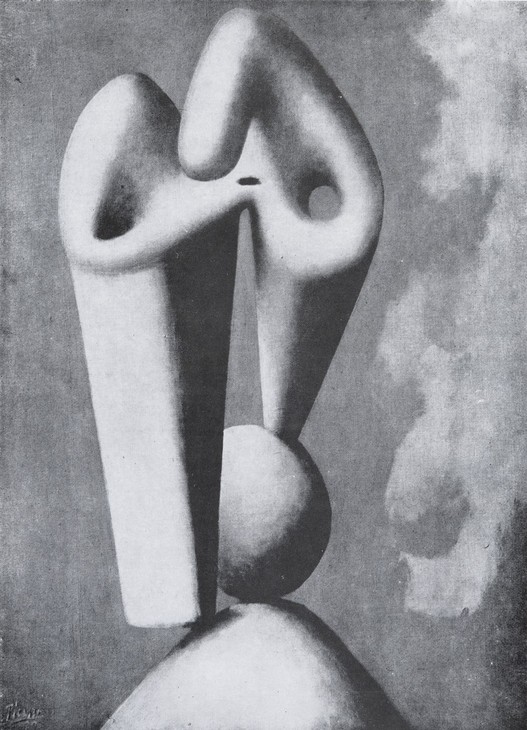
Pablo Picasso
Untitled 1929, reproduced in Documents 3: Hommage à Picasso, 1930
© Succession Picasso/DACS
Fig.4
Pablo Picasso
Untitled 1929, reproduced in Documents 3: Hommage à Picasso, 1930
© Succession Picasso/DACS
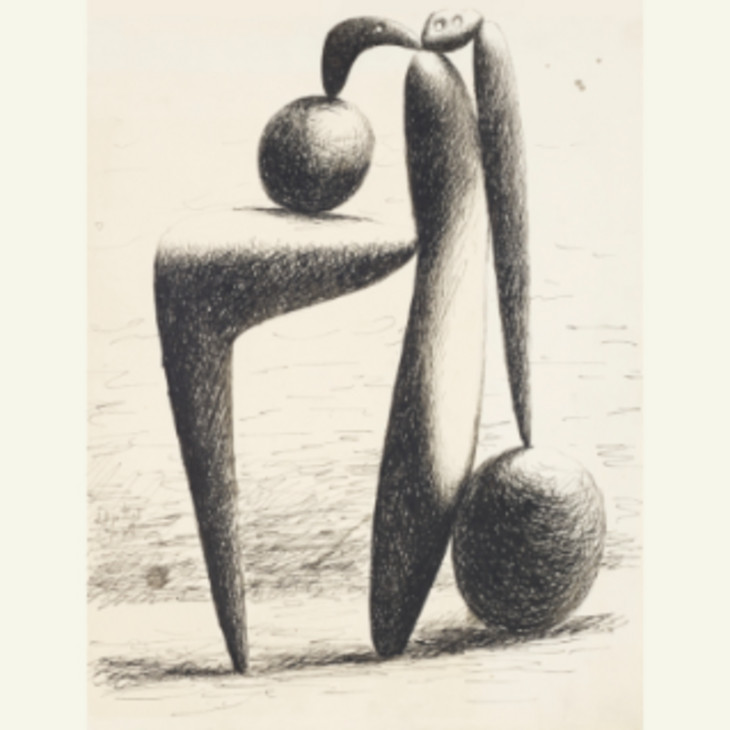
Pablo Picasso
Project for a Monument 1928
Graphite on paper
Private collection
© Succession Picasso/DACS
Fig.5
Pablo Picasso
Project for a Monument 1928
Private collection
© Succession Picasso/DACS
Moore had been aware of Picasso’s work since his student days at Leeds School of Art, and in 1973 reflected that ‘really all my practising life was as a student, and as a sculptor I have been very conscious of Picasso because he dominated sculpture and painting – even sculpture as well as painting – since Cubism’.34 According to the art historian Christopher Green, Moore’s move from what might be called figurative, albeit, non-naturalistic sculpture, such as Half-Figure 1932 (Tate T00241), to more abstract work such as Composition, made the same year, can be explained in relation to Picasso’s fragmented, gelatinous figures reproduced in Cahiers d’Art and Documents. Picasso’s series of sculptural drawings, Projects for a Monument 1928 (fig.5), presents the human body as a sequence of precariously balanced vertical beams positioned alongside two ovoids and capped with a boomerang shape and a third, smaller ovoid, pierced with two holes, which may represent eyes. For Green, Moore’s affinity with Picasso was rooted ‘in their knowledge of the human body, however far they moved from straight representation’.35
In 1970 the art critic Robert Melville’s monograph on Moore considered the artist in relation to surrealism, observing that ‘during the period from 1931 to the beginning of the war, Moore carved a superb series of organic abstractions. They are as “shape conscious” as the sculpture of [Constantin] Brancusi and [Jean] Arp, but they are more persistently penetrated by human associations, and they reveal his connections with Surrealism. He belongs to the Surrealist generation’.36 Moore’s Hampstead friends Herbert Read and Roland Penrose were at the centre of the surrealist movement in England and Moore exhibited in a number of surrealist exhibitions throughout the 1930s and co-organised the International Surrealist Exhibition in London in 1936. According to Melville, although Moore ‘took no part in the doctrinal discussions’ of the surrealists, he nonetheless developed and utilised a ‘Surrealist inventiveness’ in his work.37
Although he did not elaborate on Arp’s work, Melville’s reference to the German-French surrealist sculptor was apposite. Examples of work by the two artists had been reproduced alongside each other in the art journal Minotaure in 1937 as examples of surrealist sculpture, and the art historian Michel Remy has suggested that Moore met Arp during one of his many visits to Paris in the 1930s.38 Prior to the First World War Arp had worked within a cubist style, but during the late 1910s and early 1920s his work became more curvilinear. His sculptures, such as Sculpture to Be Lost in the Forest 1932, cast c.1953–8 (fig.6) incorporated botanical forms, evoking weathered pebbles or swollen buds. Arp used irregularly rounded shapes to express a fluid balance of forces that he felt characterised natural forms and symbolised the idea of nature as the seat of a non-rational order. The original plaster version of Sculpture to Be Lost in the Forest was one of a number of works from the early 1930s identified under the generic title ‘Concretions’. As Arp explained in 1958:
Concretion signifies the material process of condensation, hardening, coagulating, thickening, growing together. Concretion designates the solidification of a mass. Concretion designates curdling, the curdling of the earth and the heavenly bodies. Concretion designates solidification, the mass of the stone, the plant, the animal, the man. Concretion is something that has grown.39
Adjectives such as condensing, hardening, thickening and growing could also be used in descriptions of Composition and it is possible to regard Moore’s work as a response to Arp’s conception of concretion. Writing in the French journal XXe Siècle between 1938 and 1939 the critic Pierre Guéguen made an implicit link between the work of Moore and Arp though this idea of concretion. As Julia Kelly has explained, Guéguen regarded Moore’s work as an ‘exemplar of sculpture in its bodily relation to the viewing subject, as a realisation of the haptic impulse and as a microcosmic distillation of the body in the external world of nature’.40 Guéguen used the term ‘calcul de caresses’ to characterise Moore’s work, which Kelly has described as ‘untranslatable’.41 Nonetheless, she explains that ‘calcul’ suggests both the way in which an understanding of the world is calculated through the sense of touch and through the natural process of concretion within the body, for example, the way in which a kidney stone grows and hardens within the body.
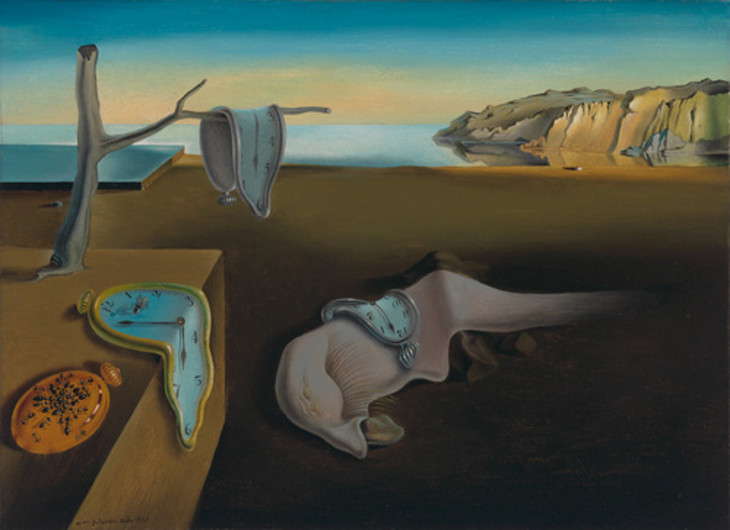
Salvador Dalí
The Persistence of Memory 1931
Oil paint on canvas
241 x 330 mm
Museum of Modern Art, New York
© 2014 Salvador Dalí, Gala-Salvador Dalí Foundation / Artists Rights Society (ARS), New York
Fig.7
Salvador Dalí
The Persistence of Memory 1931
Museum of Modern Art, New York
© 2014 Salvador Dalí, Gala-Salvador Dalí Foundation / Artists Rights Society (ARS), New York
Tactile experience is very important as an aesthetic dimension in sculpture. Our knowledge of shape and forms remains, in general a mixture of visual and of tactile experiences ... sculpture with tactile exaggerations can be so much more exciting.43
Composition is illustrated in Herbert Read’s 1934 publication, Henry Moore: Sculptor. Most of the sculptures illustrated in this book are accompanied by the name of their owner, but no owner is identified for Composition. It is therefore likely that the sculpture remained unsold after its inclusion in Moore’s 1933 exhibition at the Leicester Galleries and thus returned to the artist’s personal collection, where it remained while Read was preparing his book. Although the sculpture’s exact date of sale has yet to be determined, it is known that Composition entered the collection of Michael Ventris some time prior to 1944 and was probably bought directly from the artist. While Moore sold his work through commercial galleries such as the Leicester Galleries, he also conducted private sales, where clients would purchase sculptures from him directly. No correspondence survives regarding the sale of the sculpture, but it is probable that Ventris and Moore were known to each other as they moved within the same artistic circles in Hampstead.
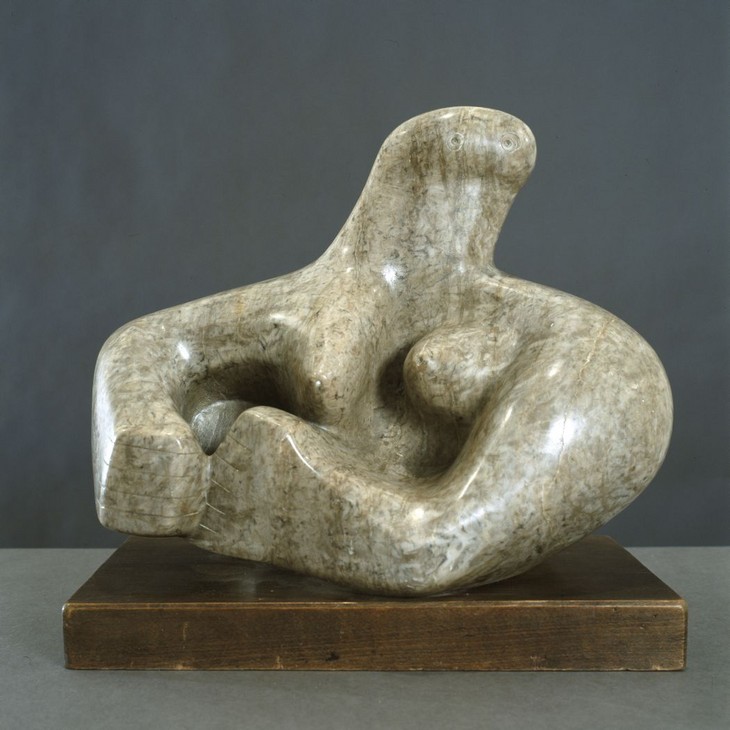
Henry Moore
Composition 1931
Cumberland alabaster
The Henry Moore Foundation
© The Henry Moore Foundation. All Rights Reserved
Photo: Michael Phipps, Henry Moore Foundation Archive
Fig.8
Henry Moore
Composition 1931
The Henry Moore Foundation
© The Henry Moore Foundation. All Rights Reserved
Photo: Michael Phipps, Henry Moore Foundation Archive
1940 was a turning point in Ventris’s life. He published his first article on Linear B in the American Journal of Archaeology, he commenced his training as an architect at the Architectural Association School of Architecture, London, and his mother committed suicide. At the time of her death, her apartment contained paintings by Picasso and Juan Gris and sculptures by Gabo and Moore. Although it is unclear when the Highpoint apartment was sold, in 1952 Ventris and his wife, Lois Knox-Niven, a fellow student at the Architectural Association, built a house in Highgate based around Breuer’s furniture that he had inherited.
Ventris’s ownership of Composition and two other works by Moore was noted in the book Henry Moore: Sculpture and Drawings published in 1944. Thereafter he regularly loaned Composition (and Composition 1931) to Moore’s international touring exhibitions, for example to the Museum of Modern Art, New York, in December 1946, and to a series of touring exhibitions organised by the British Council between 1947 and 1953. According to records held in the Tate Archive, when Ventris loaned Composition for Moore’s exhibition at Zappeion Gallery, Athens in March 1951, it was insured for the sum of £250. In a letter to Ventris dated 16 November 1950, Lillian Somerville, Director of the Fine Arts Department at the British Council, thanked him for his kind loan. She wrote,
We had intended not to bother owners who had lent for previous exhibitions but we thought you would not mind our asking you to lend again as you had asked us to look after your two sculptures a little longer. In fact Henry Moore himself suggested we should ask you if we could send them to Greece as he thinks that they are among the most important he did at the time.49
When the exhibition in Athens was de-installed in early April 1951 it was reported that ‘one of the workmen tipped the “Composition, African wonderstone” against the next piece. This has made a small bruise about 3 mm across on the upper concentric graining. The mark appears to be only superficial’.50 Moore inspected the sculpture on its return to London, and Somerville reported to her colleagues in Athens that ‘although he has noticed a new scratch he seems to think that the mark you mention was old damage’.51
In November 1955 Ventris sold Composition to Irina Moore. It is unclear why Ventris decided to sell this sculpture and not the ebony Figure, which remained in the family collection until the 1980s. Composition remained in the possession of Irina Moore until 1960, when she sold it to the Friends of the Tate Gallery. During the late 1950s the Trustees of the Tate were keen to expand the gallery’s holdings of Henry Moore’s work. Following discussions with the Director, Sir John Rothenstein, Moore proposed a list of eight works, which was presented to the trustees at their meeting on 16 May 1957.52 Although these works were not purchased immediately, the list, which included an example of each of Moore’s different subjects and materials to date, became the blueprint used by the Friends of the Tate for their acquisition of six sculptures by Moore in 1960. A letter dated 1961 from Jane Lascelles, organising secretary for the Friends, to Henry Moore notes that there was no correspondence about the terms of the sale of Moore’s sculptures in the Friends’ files, suggesting that the particulars of the sale were made verbally with Moore.53 The six sculptures presented by the Friends to the Tate in December 1960 were Composition 1932, Stringed Figure 1938, cast 1960 (Tate T00386), Reclining Figure 1939 (Tate T00387), Helmet Head No.1 1950 (Tate T00388), Mother and Child 1953 (Tate T00389), and Working Model for Unesco Reclining Figure 1957 (Tate T00390).
In 1972 Composition was included in the groundbreaking exhibition Sculpture for the Blind, in which twelve sculptures from Tate’s permanent collection were exhibited for blind and partially sighted visitors, who were encouraged to experience the works through touch. The exhibition was supplemented by loans made from Moore’s personal collection. In a review of the exhibition, critic Harold Osborne determined that ‘the Tate Gallery has shown commendable imagination and initiative in staging this exhibition’,54 and letters held in The Henry Moore Foundation Archive reveal that blind audiences appreciated the opportunity to experience Moore’s sculptures through touch.55 In December 1976, a C. Simms of Ilford, Essex, wrote to thank Terry Measham, Assistant Keeper at the Tate, for curating the exhibition. Simms wrote:
I had no idea of the pleasure and sense of satisfaction I would gain from abstract works ... ‘Composition’ was fascinating in all sorts of ways ... May I thank ... the Tate for a tactile meaningful experience in an area of art where I thought it did not exist.56
Alice Correia
January 2013
Notes
Herbert Read, ‘A Nest of Gentle Artists’, Apollo, September 1962, pp.536–40. See also Nicholas Thornton, ‘Introduction’, in Moore, Hepworth, Nicholson: A Nest of Gentle Artists in the 1930s, exhibition catalogue, Norwich Castle Museum and Art Gallery, Norwich 2009, p.2.
Andrew Causey, ‘Herbert Read and Contemporary Art’, in David Goodway, Herbert Read Reassessed, London 1998, p.127.
Henry Moore cited in Arnold Haskell, ‘On Carving’, New English Weekly, 5 May 1932, p.65–6, reprinted in Alan Wilkinson (ed.), Henry Moore: Writings and Conversations, Aldershot 2002, p.190.
Henry Moore, ‘Statement for Unit One’, in Herbert Read (ed.), Unit One: The Modern Movement in English Architecture, Painting and Sculpture, London 1934, pp.29–30, reprinted in Wilkinson 2002, p.192.
Frank Rutter, ‘Quoth the Raven: Henry Moore, His sculpture’, Sunday Times, 12 November 1933, Henry Moore Foundation Archive.
Anon., ‘Sculpture and Drawings by Henry Moore at the Leicester Galleries’, Apollo, December 1933, p.389.
Adrian Stokes, ‘Art: Mr Henry Moore’s Sculpture’, Spectator, 10 November 1933, Henry Moore Foundation Archive.
See Alan G. Wilkinson, Henry Moore Remembered: The Collection at the Art Gallery of Ontario in Toronto, Toronto 1987, p.71.
Jennifer Mundy, ‘Comment on England’, in Chris Stephens (ed.), Henry Moore, exhibition catalogue, Tate Britain, London 2010, p.28.
Christopher Green, ‘Henry Moore and Picasso’, in James Beechy and Chris Stephens (eds.), Picasso and Modern British Art, exhibition catalogue, Tate Britain, London 2012, p.139.
George Wingfield Digby, Meaning and Symbol in Three Modern Artists: Henry Moore, Edvard Munch, Paul Nash, London 1955, pp.70–1.
For a facsimile of Documents, vol.2, no.3, 1930, see http://gallica.bnf.fr/ark:/12148/bpt6k32951f.image , accessed 30 July 2012.
Henry Moore, ‘Interview with Elizabeth Blunt’, Kaleidoscope, BBC Radio 4, 9 April 1973, transcript reprinted in Wilkinson 2002, p.167. For discussions of the debt Moore owed to Picasso see Herbert Read, Modern Sculpture, London 1964, pp.168–73, and Lichtenstern 2008, pp.47–52.
John Russell, Henry Moore, 1968, 2nd edn, London 1973, p.74; Michel Remy, Surrealism in Britain, Aldershot 1999, p.70. Although Remy does not provide evidence as to when or where Moore and Arp met, it is his contention that they did meet.
Julia Kelly, ‘The Unfamiliar Figure: Henry Moore in French Periodicals of the 1930s’, in Jane Beckett and Fiona Russell (eds.), Henry Moore: Critical Essays, Aldershot 2003, pp.58–9.
Moore recalled that he met Dalí ‘before he was well known, before he started being odd’. See John Hedgecoe (ed.), Henry Moore: My Ideas, Inspiration and Life as an Artist, London 1986, p.72.
Henry Moore cited in Edouard Roditi, Dialogues on Art, London 1960, pp.184–5, reprinted in Wilkinson 2002, p.210–1.
Furniture by Breuer from the Ventris commission was sold at Sotheby’s in 2002 and was purchased by the Victoria and Albert Museum, London, with assistance from The Art Fund. See, for example, http://collections.vam.ac.uk/item/O81735/desk-breuer-marcel/ , accessed 30 July 2012.
See Michael Ventris, letter to Marcel Breuer, 25 June 1939, Breuer Papers, Syracuse University Library, http://breuer.syr.edu/xtf/view?docId=mets/3065.mets.xml;query=michael%20ventris;brand=breuer, accessed 30 July 2012.
Extensive correspondence between Michael Ventris and Naum Gabo is held in the Yale University Archive. See the Naum Gabo Papers, Beinecke Rare Book and Manuscript Library, Yale University Archive, YCAL MSS 541, http://drs.library.yale.edu:8083/HLTransformer/HLTransServlet?stylename=yul.ead2002.xhtml.xsl&pid=beinecke:gabo&query , accessed 30 July 2012.
H.A. Lidderdale, letter to Fine Art Department, British Council, 9 April 1951, Tate Archive TGA 9712/2/48.
Lilian Somerville, letter to the Functional Officer, British Council in Athens, 26 April 1951, Tate Archive TGA 9712/2/48.
Related essays
- Henry Moore and Direct Carving: Technique, Concept, Context Sarah Victoria Turner
- Ambivalence and Ambiguity: David Sylvester on Henry Moore Martin Hammer
- Life Forms: Henry Moore, Morphology and Biologism in the Interwar Years Edward Juler
- Erich Neumann on Henry Moore: Public Sculpture and the Collective Unconscious Tim Martin
- Henry Moore and Stone: Methods and Materials Sebastiano Barassi and James Copper
Related catalogue entries
Related material
Related reviews and articles
- Henry Moore, ‘On Carving’ New English Weekly, 5 May 1932, pp.65–6.
How to cite
Alice Correia, ‘Composition 1932 by Henry Moore OM, CH’, catalogue entry, January 2013, in Henry Moore: Sculptural Process and Public Identity, Tate Research Publication, 2015, https://www

